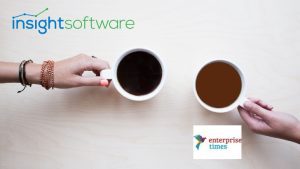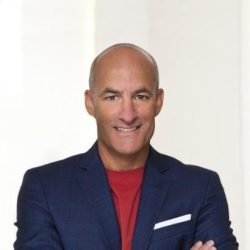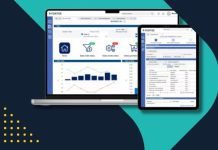
Who are insightsoftware?
Enterprise Times asked Triandiflou to give an elevator pitch for insightsoftware. He replied, “At the centre of everything we do is a company’s business data. We help companies harness their data to run a better business. More than half of that is around the office of the CFO.
“In the office of the CFO, there are about 25 or so different categories of software that a company will use to run their finance operation. The centre of that is the ERP system, the general ledger. We don’t do the GL, and we have no plans to do the GL. But there’s a lot that wraps around the GL, and we want to do a lot of that.

Chief Executive Officer at insightsoftware
“Out of those 25 categories, we’re in nine categories today. We see ourselves being in about 15 different categories of software that will be for the office of the CFO. Beyond the office of the CFO, we have some operational reporting products too. They harness that business data we do a lot in supply chain and embedded analytics.”
How large is insightsoftware, and can you share revenue and growth?
“We don’t share specific revenues, but I can give you the others. We have a little shy of 2,500 team-mates people in the company and over 30,000 customers. Our growth rate is ballpark 50%. It varies based on our acquisitions. We do lots of acquisitions. I’ve been at the company for less than two years, and we’ve almost tripled in the last two years. We are growing very, very quickly, both through acquisition and our organic growth. We’re double-digit growing organically as well.”
On Vision
What’s your vision for insightsoftware?
“We will have arrived when a CFO needs software, and they say to their IT staff, go call insightsoftware, see if they have that, see if they can help us. Because they’re using, hopefully, three, four, or five, six of our software products already. They know they trust us, we provide good service, and they know our products work well together.
“When doing all these acquisitions, one of the biggest initiatives in the company is to move our products onto a common platform. When you make acquisitions, products are from different companies. You have got to get that commonality, the same look and feel, the same workflow, and be able to pass data between products.
“That’s a huge initiative in our company. We’ll have eight products on the platform by the end of this year. Almost 20 on the platform by the end of next year. That’s more than half of our revenue as a company. Our vision is to want senior executives manipulating data, particularly CFOs. When they need software, we want them to call us.”
When you say a platform, is that a common technology stack such as Microsoft?
“We use Microsoft technologies, but we buy things that are all different technologies. There are ways you can stitch that together and pass data. It may not be one code set under the covers, but from the user experience perspective, the look and feel look very similar, and the data flows. What real people care about is data flow.”
“I’ll give you a simple example. Every company in the world has a budget. Last year’s actuals are the first things you need in the budgeting process. Last year’s actuals come out of our reporting system. It can flow nicely right into our budgeting system. Once you have a budget, you can compare actuals to that using our embedded analytics. These are just simple use cases on how our products fit together.”
On insightsoftware partnerships
Besides Microsoft, what are the other partnerships insightsoftware has?
“We have a bunch of different partnerships. Microsoft is probably our closest. Beyond Microsoft, we have many acquired products we run on Amazon Web Services. We also have outsourced partnerships with vendors that help us provide development services.”
What is the channel strategy?
“About a third of our business comes through the channel. It’s a really big part of our company. We have all flavours. I’ll give you a couple of examples. We have a product called Jet reporting that is sold through the Microsoft reseller channel. That’s lots of small deals; the average deal might be 5 to 10 grand.
“On the other end of the spectrum, we have a tax product called Longview. Longview works very closely with the global systems integrators Deloitte, Accenture and PWC. We have a product called SourceConnect, that pulls data out of ERP systems. When SAP is doing a new implementation, they use that to migrate data out of the legacy ERP. SAP is our reseller. We have all flavours.”
On 2022
What have you achieved this year?
“Growth! We have expanded in Europe. I think three of the four acquisitions are in Europe, which is a conscious strategy. Our latest investment came from Hg, which is in London. That’s been helpful to us in opening more doors with companies in the UK and throughout EMEA.
“We are growing and are also expanding globally. We bought a company in Australia. I guess that was at the end of last year. We aspire to be a global company. Today, over 50% of our employees are outside the United States. So we have a very global workforce, and about 40% of our revenues come from outside the United States.”
On the future and growth
What do you hope to achieve in the next six to 12 months?
“I’d say continued growth, but I’ll be a little more specific. We are very focused on selling more products to our existing customers. We have over 30,000 customers, and less than 1,000 have more than one of our products. So it’s an incredible opportunity for us. That’s why getting products onto this common platform is very important.
“We would like our existing customers to buy a second or third, or fourth product from us. We will be a bigger and more important partner for them. It’s an easier way to grow our business than doing net news. We will do both. We will continue to acquire businesses. There are a few specific segments of the market that we want to get into with our acquisitions. Our acquisitions all flow out of our product strategy.”
What about the rest of the world? What about Africa, as companies are starting to invest there?
I would say it’s not a strategic priority. We have some employees in South Africa and a good bit of business in South Africa. From a prioritisation standpoint, that’s more opportunistic than strategic. We don’t have a large presence in South America. We don’t have a large presence in India, China, or Japan. Some markets like that are a little bit higher on our wish list.
You have a development centre in India, though, don’t you?
“We have over 300 employees in India now.”
Is that a market you want to go into?
“We do. We don’t have a big presence in terms of the number of customers.”
On the target market
What is your target market?
“Our roots are in the mid-market. More than half our revenue comes from mid-market. We define that as under a billion USD in revenue. However, we are doing more and more in the enterprise. Logi is an enterprise company. We bought Magnitude, which was an enterprise company, and Longview is an enterprise company. Our bread and butter is amid companies with three to six hundred million in revenue.”
How do you see the competitive market evolving in the next year?
“There’s always consolidation that happens, and you have new players crop up, so it’s almost like a cycle. On one end of the spectrum, our competitors are the big ERP (firms). A lot of them say they do what we do, even though they may be an inch deep and a mile wide. We always watch what the big guys are doing: Oracle, SAP, and Microsoft. We always pay attention to that. Then we pay attention to the niche players; if they look good, we like to buy them. The market changes fast. You can never be too comfortable.
“We haven’t seen dramatic changes in pricing. We haven’t seen any new rocket ship competitor come in; that’s really kicking butt. Each market is different. It’s different in the UK than it is in the US and different in Australia. So we keep an eye on it. But it seems to be a relatively stable, normal evolution of our market.”
On challenges
What are your challenges as CEO?
“I always say I worry about two things, good hires and bad acquisitions. You always want to hire great people. And hiring has been tough, that’s something that has changed. The labour market in Q1 was brutal; in Q3, it’s much more normalised and noticeably different. I always think about getting good people and talent in the company. We grow so fast. We always have hiring needs.
“Then a bad acquisition can set you back a year or two. In our early days, we did acquisitions of companies that might be $10,$20, or $30 million in turnover. Now we do ones that are $50, $100, or $200 million in turnover. There’s more risk when you do bigger deals like that, but we need to do that, given our size, to move the needle. So I always worry about bad acquisitions.”
The book question
What was the latest book you read? And what was your take out for business from it?
“I just finished a great book by Ray Dalio. It is a fascinating book. It’s called “Principles for Dealing with the Changing World Order: Why Nations Succeed or Fail” (Amazon Aus, UK, US). The whole premise of the book is that things happened in our lifetimes that we think are shocking because it just happens once in our lifetime. You look back 2000 years, and these things have been happening forever. The pandemic would be an obvious one.
“Part of it is the rise and fall of countries. The United States has been on this incredible roll for the last 100-150 years, but it’s probably in cyclical decline right now. China’s on the rise, but it looks at past empires, the Dutch Empire, the British Empire, what they call the US Empire, and the predictability of it and the drivers of it.”

























